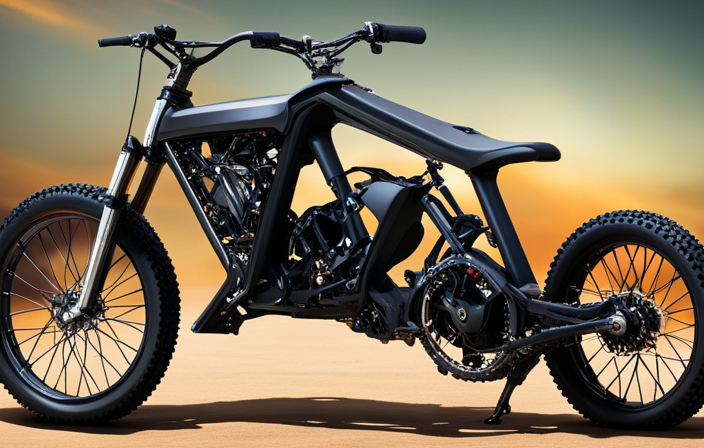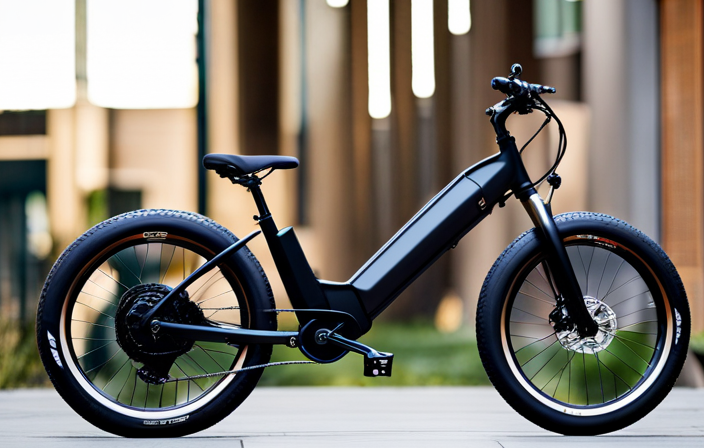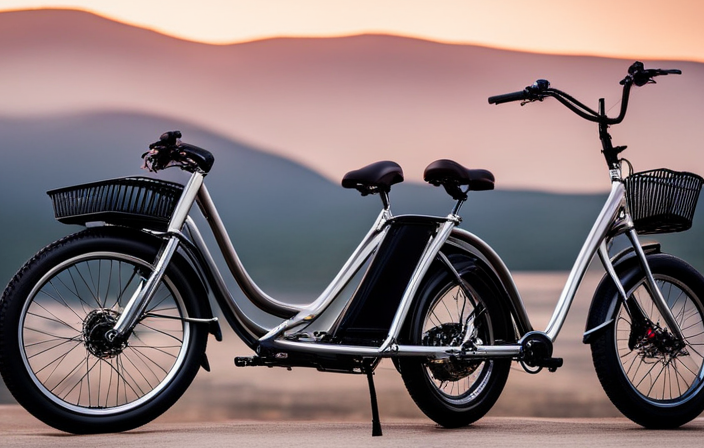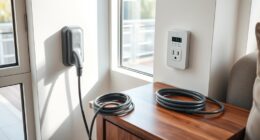Removing the rear wheel on an electric bike may seem like a daunting task, but with the right tools and careful steps, it can be accomplished smoothly. In this guide, I will walk you through the process, ensuring that you follow each step precisely.
By disconnecting the battery, loosening the quick-release lever or axle nuts, and reattaching the chain and brake tension, you’ll be able to remove and reinstall the rear wheel confidently.
Let’s get started!
Key Takeaways
- Disconnect the battery and remove the chain before removing the rear wheel.
- Shift gears to the smallest chainring and rear cog before loosening the quick-release lever or axle nuts.
- Release brake tension and lift the rear of the bike using a bike stand for stability.
- Inspect the wheel for misalignment, tire wear, and proper tire pressure before reinstalling the rear wheel.
Gather the necessary tools
Gather the necessary tools to remove the rear wheel on an electric bike.
The rear wheel removal process requires a few specific tools to ensure a smooth and efficient task.
Firstly, you will need a set of Allen wrenches or a socket wrench with the appropriate size to fit the axle nuts. This will allow you to loosen and remove the nuts holding the wheel in place.
Additionally, a pair of pliers or a wrench may be necessary to disconnect the brake caliper, if present.
It is also recommended to have a bike stand or a sturdy object to prop the bike up on, ensuring stability and ease of access.
With these tools at hand, you are ready to proceed to the next step: turning off the electric bike and disconnecting the battery.
Turn off the electric bike and disconnect the battery
First, make sure the e-bike is powered off and the battery is disconnected.
-
Troubleshooting common issues with electric bike batteries:
-
Check if the battery is fully charged.
-
Inspect the battery connections for any loose or corroded wires.
-
Replacing the battery on an electric bike:
-
Locate the battery compartment, usually found near the rear wheel.
-
Remove any screws or latches securing the battery in place.
-
Carefully disconnect the battery cables, ensuring not to damage any wires.
-
Slide the old battery out of the compartment and set it aside.
-
Insert the new battery into the compartment, aligning it properly.
-
Reconnect the battery cables, ensuring a secure connection.
-
Secure the battery in place using screws or latches.
To continue with the process, shift the gears to the smallest chainring and the smallest rear cog.
Shift the gears to the smallest chainring and the smallest rear cog
Next, shift the gears to the smallest chainring and rear cog. This adjustment is crucial when removing the rear wheel of an electric bike. By adjusting the gear ratios to the smallest options, it ensures that the chain is loose and allows for easier removal of the wheel. To help you better understand the importance of this step, take a look at the following table:
| Chainring | Rear Cog | Gear Ratio |
|---|---|---|
| Small | Small | 1:1 |
| Small | Medium | 1:2 |
| Small | Large | 1:3 |
Troubleshooting shifting issues is easier with this setup, as it eliminates any potential complications caused by the gear system. Now, we can smoothly transition into the subsequent section about loosening the quick-release lever or axle nuts.
Loosen the quick-release lever or axle nuts
To start this step, you’ll want to loosen either the quick-release lever or the axle nuts. This will allow you to remove the rear wheel on your electric bike.
If your bike has a quick-release lever, simply flip it open to release the tension on the wheel.
If your bike has axle nuts, you’ll need to use a wrench to loosen them. Start by inserting the wrench onto the nut and turning it counterclockwise. Keep loosening until the axle nuts are completely free.
If you encounter any resistance or difficulty, make sure the chain is properly aligned and not caught on anything. Additionally, check for any dirt or debris that may be obstructing the axle nuts.
Once you have successfully loosened the quick-release lever or axle nuts, you can move on to the next step of releasing the brake tension.
Release the brake tension
To release the brake tension, gently squeeze the brake lever. This will move the brake pads closer to the rim, making it easier to remove the rear wheel.
Here are four essential steps to adjust the brake pads and troubleshoot any brake issues:
-
Inspect the brake pads for wear and tear. If they are worn out or unevenly worn, replace them with new ones.
-
Loosen the brake cable using the barrel adjuster. This will create more slack in the cable, making it easier to remove the wheel.
-
Align the brake pads with the rim by adjusting the brake pad position using the mounting bolts. Make sure they make even contact with the rim surface.
-
Test the brake function by squeezing the lever. If the pads are not gripping the rim evenly or if there is excessive play, further adjustments may be needed.
Once the brake tension is released and adjusted correctly, you can proceed to lift the rear of the bike off the ground for wheel removal.
Lift the rear of the bike off the ground
To safely lift the rear of the bike off the ground, I recommend using a bike stand for stability. This will prevent the bike from tipping over and ensure that you can work on it securely.
First, position the bike stand so that the rear wheel rests on it. Make sure the stand is securely fastened and stable.
Next, carefully lift the rear of the bike, using the bike stand as a support. It’s important to maintain a firm grip and lift evenly to avoid any accidents.
Once the rear wheel is lifted off the ground, you can proceed to the next step of removing the chain from the rear derailleur. This will allow for the safe removal of the rear wheel without any interference from the chain.
Remove the chain from the rear derailleur
Once the chain is detached from the rear derailleur, you can proceed with the next steps.
To ensure that your electric bike performs at its best, it’s important to discuss two additional ideas: adjusting the rear derailleur for smoother shifting and lubricating the chain for better performance.
To adjust the rear derailleur, follow these steps:
- Shift the chain onto the smallest rear cog and smallest front chainring.
- Locate the barrel adjuster on the rear derailleur and turn it clockwise to tighten or counterclockwise to loosen.
- Pedal and shift through the gears, making small adjustments to the barrel adjuster until the shifting becomes smoother.
- Once satisfied with the adjustments, shift back to the smallest rear cog and smallest front chainring to ensure proper alignment.
After adjusting the rear derailleur, it’s time to lubricate the chain. Apply a high-quality bicycle chain lubricant evenly along the entire length of the chain, spinning the pedals backward to ensure thorough coverage.
With the chain removed and these adjustments made, you are now ready to slide the rear wheel out of the dropouts.
Slide the rear wheel out of the dropouts
Now you can simply slide out the rear wheel from the dropouts.
To remove the rear wheel on an electric bike, it is important to perform regular bike maintenance. This ensures the smooth functioning of the bike and prevents any potential damage or wear.
Start by shifting the chain onto the smallest chainring and the smallest rear cog. This will ease the process of removing the wheel.
Next, release the quick-release lever or loosen the bolts on the wheel axle. Once this is done, hold onto the handlebars and lift the bike slightly off the ground.
Gently slide the rear wheel out of the dropouts, making sure to guide the chain through the rear derailleur.
Once the wheel is removed, it is important to inspect it for any damage or wear, as this will allow you to address any issues before reinstalling it onto the bike.
Inspect the wheel for any damage or wear
After sliding the rear wheel out of the dropouts, it’s important to inspect it for any damage or wear. Here are the steps to follow:
-
Inspect wheel alignment: Place the wheel on a flat surface and check if it spins freely without wobbling. Look for any signs of misalignment, such as a bent rim or loose spokes. Adjust as necessary.
-
Check for tire pressure: Use a tire pressure gauge to ensure the tire is adequately inflated. Refer to the manufacturer’s recommendations for the correct pressure. Low tire pressure can affect the bike’s performance and increase the risk of flats.
-
Examine the tire tread: Look for excessive wear, cracks, or cuts on the tire tread. Replace the tire if it is worn out or damaged beyond repair.
-
Assess the brake system: Inspect the brake pads for wear and make sure they are properly aligned with the rim. Replace worn pads and adjust their position if needed.
Once you have thoroughly inspected the rear wheel, you can proceed to replace or repair any necessary components.
Replace or repair any necessary components
To complete the process, you’ll need to determine if any components need to be replaced or repaired. When it comes to deciding between replace or repair, the most cost-effective option depends on the specific component and its condition.
Some common components that may need replacing or repairing on electric bikes include the spokes, rim, tire, tube, cassette, and freewheel. Inspect each of these parts carefully for any signs of damage or wear.
If the component is severely damaged or worn out, it is generally more cost-effective to replace it with a new one. However, if the damage is minor or can be fixed easily, repair might be the better option.
Now that you have assessed the condition of the components, you can move on to the next step of reinstalling the rear wheel into the dropouts.
Reinstall the rear wheel into the dropouts
Once you have determined if any components need replacing or repairing, you can proceed to reinstalling the rear wheel into the dropouts. Follow these steps to ensure a proper installation:
- Start by aligning the rear derailleur with the smallest gear on the cassette.
- Carefully slide the wheel into the dropouts, making sure that the axle fits snugly into the slots.
- Once the wheel is in place, tighten the axle nuts or quick release skewer to secure it.
- Next, adjust the brake calipers by loosening the mounting bolts and centering them over the brake rotor. Then, tighten the bolts to secure the calipers in place.
- Finally, check the alignment of the rear derailleur and make any necessary adjustments to ensure smooth shifting.
With the rear wheel reinstalled and the brake calipers adjusted, you can now move on to the next step of reattaching the chain to the rear derailleur.
Reattach the chain to the rear derailleur
Now you can reattach the chain to the rear derailleur. Make sure the chain is properly aligned with the gears on the rear wheel. Here is a step-by-step guide to help you with this process:
-
Begin by placing the chain onto the smallest rear gear on the cassette.
-
While holding the chain in place, gently pull the derailleur arm backwards to create tension in the chain.
-
Carefully guide the chain onto the rear derailleur pulley wheels.
-
Once the chain is in position, release the derailleur arm slowly, allowing it to move back into its natural position.
-
Check the chain tension by shifting through the gears. The chain should move smoothly and without any skipping or jumping.
By following these steps, you should be able to reattach the chain to the rear derailleur successfully. Now, we can move on to reconnecting the brake tension.
Reconnect the brake tension
Now you can focus on reconnecting the brake tension, ensuring that it is properly aligned and functioning correctly.
Start by locating the brake cables that were detached earlier. Carefully thread the cables through the cable housing and ensure that they are correctly seated in the brake levers.
Next, position the brake caliper so that it is aligned with the brake rotor. Tighten the bolts on the caliper to secure it in place, but be careful not to overtighten.
Once the caliper is properly positioned, squeeze the brake lever to check if the brake pads engage with the rotor. If necessary, adjust the brake caliper position until the pads make proper contact with the rotor.
With the brake tension reconnected and adjusted, you are now ready to move on to the next step of tightening the quick-release lever or axle nuts.
Tighten the quick-release lever or axle nuts
To ensure a secure fit, tighten the quick-release lever or axle nuts. If your electric bike is equipped with a quick-release lever, you will need a 5mm Allen wrench or a lever-specific tool to tighten it. Insert the tool into the lever and turn it clockwise until it is snug. Be careful not to overtighten, as this can cause damage to the axle or hub.
If your bike has axle nuts, use a 15mm wrench to tighten them. Start by holding the wrench on one nut and turning the other clockwise until it is snug. Repeat this process for the other nut. Make sure both nuts are tightened evenly to ensure proper alignment.
Once the quick-release lever or axle nuts are tightened, you can move on to the next step of reconnecting the battery and testing the rear wheel for proper function.
Reconnect the battery and test the rear wheel for proper function
After tightening the quick-release lever or axle nuts, I can proceed to reconnecting the battery and testing for proper function.
First, I carefully align the battery connector with the corresponding socket on the electric bike frame. I push the connector in firmly until it clicks into place.
Next, I turn on the bike’s power switch to activate the rear wheel. I listen for any unusual sounds or vibrations and visually inspect the wheel for smooth rotation.
To test the battery life, I engage the throttle and observe the power output. If the battery charge is low, it may indicate the need for a recharge.
Lastly, I check for any loose connections by gently wiggling the battery and ensuring that it remains securely attached to the frame.
By following these steps, I can ensure that the rear wheel functions properly and the battery is securely connected.
Frequently Asked Questions
Can I remove the rear wheel without disconnecting the battery on my electric bike?
Yes, you can remove the rear wheel on your electric bike without disconnecting the battery. However, it is recommended to turn off the power before starting the process to ensure safety.
Do I need any special tools to remove the rear wheel on my electric bike?
Regular maintenance is crucial for electric bikes. Neglecting it can lead to costly repairs. When removing the rear wheel, avoid common mistakes like not disconnecting the battery and not using the appropriate tools. Let me guide you through the process.
How do I know if there is any damage or wear on the rear wheel?
To inspect the rear wheel for damage on an electric bike, start by visually examining the tire, spokes, rim, and axle. Check for any cracks, dents, loose spokes, or worn-out tread. Regularly maintain the rear wheel by cleaning it, lubricating the chain, and keeping proper tire pressure.
What should I do if I notice any damage or wear on the rear wheel?
If I notice any damage or wear on the rear wheel, I should promptly address it to ensure safe and efficient riding. This may involve repairing the damaged parts or replacing the worn wheel with a new one.
How do I reconnect the brake tension after removing and reinstalling the rear wheel?
To reinstall brake tension after removing and reinstalling the rear wheel on an electric bike, first, locate the brake caliper and ensure it is properly aligned. Then, adjust the tension using the barrel adjuster until the desired braking power is achieved. If troubleshooting brake tension issues, check for any loose or damaged cables and make necessary adjustments or replacements.
Conclusion
In conclusion, removing the rear wheel on an electric bike may seem like a daunting task, but with the right tools and careful steps, it can be done smoothly.
By following the outlined procedure, you can confidently detach the rear wheel for maintenance or repair purposes.
For example, imagine you are on a long-distance bike trip and suddenly experience a flat tire. Knowing how to remove the rear wheel can save you from being stranded and allow you to quickly fix the issue and continue your journey.









